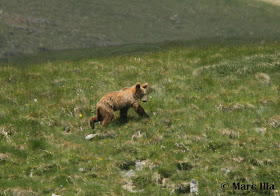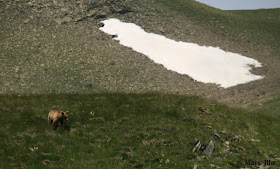During this June, and together with Albert Burgas, we spent a week surveying for the European Breeding Birds Atlas 2 (EBBA2) in Northern Greece, in collaboration with the Hellenic Ornithological Society (HOS) and the Catalan Ornithological Institute (ICO). It was my first time in Greece, and we actually discovered fantastic and very unexpected places. Thank you as well to Danae Portolou for all the coordination efforts, and to all assistants in the Atlas Camp in Kastoria! You were all very nice!!
We surveyed three areas and I'll summarise them below:
- Grammos area
North-west from Kastoria village, passing through Nestorio towards the Albanian border, a mountain region suddenly appears. It is a very big and old forest area, with a very nice mix of tree and other vegetation species, that makes a stunning landcape and habitat of many species. Also, almost abandoned villages, grasslands and rocky slopes are sometimes find in the lower parts, and subalpine grasslands and even alpine rocky habitats in the highest places (about 2400 m!).
One of the commonest passerines in the Red-backed Shrike (Lanius collurio), together with Red-rumped Swallow (Cecropis daurica), that can be extremely common and breeding in almost all kind of suitable places. In the subalpine grasslands, Northern Wheatears (Oenanthe oenanthe) and Skylarks (Alauda arvensis) -picture below- remember me the similar habitat in the Pyrenees.

But one of the best birds in the area, so far, is the Rock Partridge (Alectoris graeca), that we could see in several occasions.

The dense, old forests have quite good density of Woodpeckers, among other species. There was quite a lot of death wood on the floor, and almost all dead trunks were holey mainly because of Black Woodpeckers (Dryocopus martius).
Among many other typical forest species, Tits were quite common. Below, two pictures of juvenile Willow Tits (Poecile montanus).


One of the most unexpected things on the trip were, so far, the Brown Bears (Ursus arctos). We had already been told of the regular presence of Bears in the area, but we were not expecting at all to see them...

... and even less to see up to 6 Brown Bears in a single day! Actually, the commonest mammal... The first we saw was this immature that had probably left the mother recently. We could enjoy it during a long time while it was eating under stones up in the alpine area.



 |
| It was not very aware of our presence, and from the car, we could enjoy it even at close range. Such a stunning observation!! |
Amphibians were also quite interesting. We found several Yellow-bellied Toads (Bombina variegata) in different places. Such a nice toad, especially if you look at the underparts!



Alpine Newts (Ichthyosaura alpestris) are also very nice! In the picture below, male and female.


- Kella area and Petron lake
Kella is a small village surrounded of agricultural areas, abandoned fields and open areas with scattered bush areas and trees.

Black-headed Bunting (Emberiza melanocephala) was the star species for me!

The area is also very good for Corn Bunting (Emberiza calandra) -there's one singing in the background of the video-, Tawny Pipit (Anthus campestris), Short-toed Lark (Calandrella brachydactyla), Northern Wheatear (Oenanthe oenanthe), Eastern Black-eared Wheatears (Oenanthe melanoleuca) and Little Owl (Athene noctua) are also common species in the area.
Petron lake is a deep lake with dense reedbeds around in the middle of a very dry landscape. The reedbeds are packed with passerines, such as Great Reed Warblers (Acrocephalus arundinaceus), Reed Warblers (Acrocephalus scirpaceus), Sedge Warblers (Acrocephalus schoenobaenus), Bearded Reedlings (Panurus biarmicus), Penduline Tits (Remiz pendulinus), Reed Buntings (Emberiza schoeniclus)... Also, high density of Little Bittern (Ixobrychus minutus) and Pygmy Cormorants (Microcarbo pygmaeus), and several pairs of Ferruginous Duck (Aythya nyroca) and other wildfowl.




Eastern Olivaceous Warblers (Iduna pallida elaeica) are also common in places with a bit more of vegetation coverage.

Some non-birds in the area are both Mediterranean Turtle (Testudo hermanni) and Greek Turtle (Testudo graeca), the latter in the picture below.

This Dung Beetle was also funny to follow for a while!
- Kastoria lake and surroundings
Kastoria village, with the lake very close, is a very beautiful place. The star species so far was the Dalmatian Pelican (Pelecanus crispus), in the pictures below, and we also saw some White Pelicans (Pelecanus onocrotalus). It is very nice to look at the sky while walking around the village and see these very big birds soaring; or sitting on a terrase close to the lake while seeing them swimming nearby.


Kella is a small village surrounded of agricultural areas, abandoned fields and open areas with scattered bush areas and trees.

 |
| Petron lake, Amindeo village in the background. |

The area is also very good for Corn Bunting (Emberiza calandra) -there's one singing in the background of the video-, Tawny Pipit (Anthus campestris), Short-toed Lark (Calandrella brachydactyla), Northern Wheatear (Oenanthe oenanthe), Eastern Black-eared Wheatears (Oenanthe melanoleuca) and Little Owl (Athene noctua) are also common species in the area.
Petron lake is a deep lake with dense reedbeds around in the middle of a very dry landscape. The reedbeds are packed with passerines, such as Great Reed Warblers (Acrocephalus arundinaceus), Reed Warblers (Acrocephalus scirpaceus), Sedge Warblers (Acrocephalus schoenobaenus), Bearded Reedlings (Panurus biarmicus), Penduline Tits (Remiz pendulinus), Reed Buntings (Emberiza schoeniclus)... Also, high density of Little Bittern (Ixobrychus minutus) and Pygmy Cormorants (Microcarbo pygmaeus), and several pairs of Ferruginous Duck (Aythya nyroca) and other wildfowl.

 |
| The shores attract several birds to drink and have a bath, such as this Ortolan Bunting (Emberiza hortulana). |
Around the lake you can also find some other interesting species such as Lesser Grey Shrikes (Lanius minor) and Rock Nuthatch (Sitta neumayer).



Eastern Olivaceous Warblers (Iduna pallida elaeica) are also common in places with a bit more of vegetation coverage.

Some non-birds in the area are both Mediterranean Turtle (Testudo hermanni) and Greek Turtle (Testudo graeca), the latter in the picture below.

This Dung Beetle was also funny to follow for a while!
- Kastoria lake and surroundings
Kastoria village, with the lake very close, is a very beautiful place. The star species so far was the Dalmatian Pelican (Pelecanus crispus), in the pictures below, and we also saw some White Pelicans (Pelecanus onocrotalus). It is very nice to look at the sky while walking around the village and see these very big birds soaring; or sitting on a terrase close to the lake while seeing them swimming nearby.


 |
| Views of Kastoria from the distance. Hope I can come back soon to this amazing region!! |










